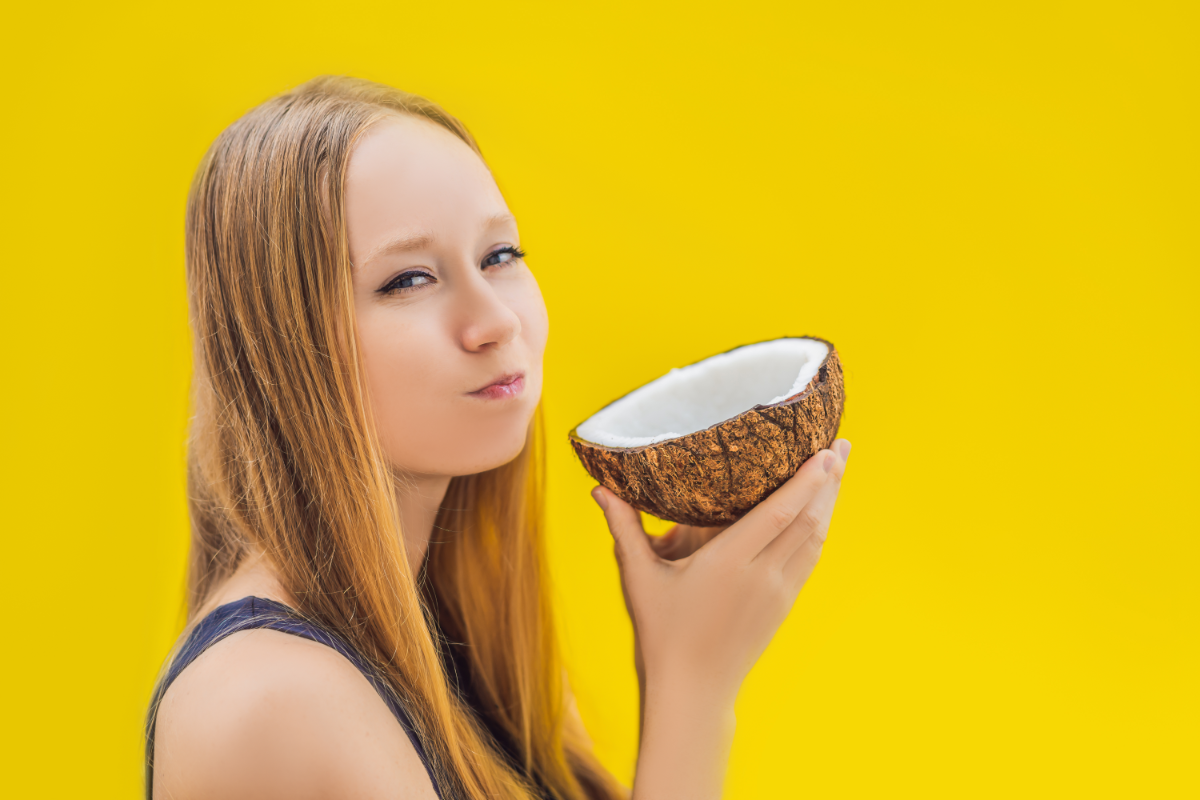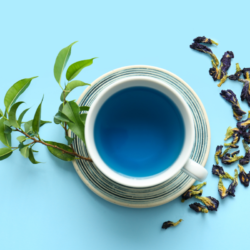Oil pulling is a traditional practice that has found a resurgence in the contemporary world of health and well-being. This method, which originated in Ayurvedicmedicine, is hailed by experts and practitioners alike for its many benefits, including improving oral health and detoxifying the body. This article offers a detailed and technical exploration of this fascinating practice.
What’s the difference between mouthwash and oil-pulling?
Oil-pulling is an Ayurvedic medical technique that involves holding a tablespoon of oil (often coconut or sesame) in the oral cavity for around 20 minutes, usually in the morning on an empty stomach. This method aims to improve oral hygiene by acting on plaque and potentially helping to whiten teeth. After circulating the oil in the mouth, oil-pullers spit out the oil and then brush their teeth as usual.
Oil pulling, an ancient practice derived from Ayurvedic medicine, has some notable differences from modern methods of oral care. Unlike commercial mouthwashes, which are often laden with chemicals and alcohol, oil pulling uses natural oils, offering a gentler alternative with no risk of chemical irritation. What’s more, while brushing and flossing are mainly mechanical, oil pulling works by chemical action, attracting and trapping bacteria and toxins in the oil. This method also acts to detoxify the body, a dimension absent from conventional dental care practices. It is important to note, however, that oil pulling does not replace brushing and flossing, but complements them by offering a holistic approach to oral health.
The origins of oil pulling
Oil pulling has its roots in Indian Ayurvedic medicine, dating back over 3,000 years. It was traditionally used as a purification method to eliminate toxins from the mouth and body.
- Ancient texts: Although widely recognised as having its origins in ancient Ayurvedic medicine, oil pulling is more than just a health practice. It is part of a holistic medical system that focuses on the balance between body, mind and environment. Ayurvedic texts such as the Charaka Samhita do not limit themselves to instructions on oil pulling, but also offer a global vision of health and well-being.
- Ayurvedic philosophy and modern health: Ayurvedic philosophy, with its roots in Indian history, finds a remarkable echo in modern concepts of integrative health. This age-old tradition, which takes a holistic approach to health, is in perfect harmony with contemporary research, particularly with regard to the importance of the oral microbiome. Modern science has revealed how the balance of the oral flora affects not only dental health, but also general well-being. By incorporating oil pulling, an Ayurvedic practice, into our oral care routines, we are embracing an approach that combines ancient wisdom with modern scientific understanding, highlighting the interconnection between oral health and the overall health of the body.
Methods and techniques
Oil pulling is a scientific and systematic method that requires an understanding of certain techniques and principles. Contrary to popular belief that it is simply a matter of swishing oil around in the mouth, the practice of oil pulling is complex and refined.
Basic technique
Oil pulling is performed by taking a tablespoon of oil into the mouth and shaking it vigorously for 15 to 20 minutes before spitting it out. Here is a technical breakdown of this method:
- Oil Selection: The oil chosen must be organic and cold-pressed. Refined and processed oils should be avoided.
- Quantity of oil: One tablespoon (about 10 ml) of oil is recommended. This quantity allows effective stirring without overloading.
- Shaking the oil: The oil should be shaken vigorously in the mouth, passing it between the teeth and around the mouth. This should be done carefully, without forcing, to avoid jaw fatigue.
- Duration: Shaking should be maintained for 15 to 20 minutes. The exact duration may vary according to the individual, but it is essential not to spit out the oil too soon.
- Spitting out the oil: The oil should be spat out into a container (not into a sink, as it can clog the drains) and disposed of properly.
Types of oil used
Different oils offer unique benefits for oil pulling. Here is a technical overview of the most commonly used oils:
- Sesame oil: Traditionally used in Ayurvedic practice, sesame oil is renowned for its rich antioxidant content, particularly sesamin and sesamolin. These compounds help to reduce plaque and strengthen the gums. What’s more, its vitamin E content contributes to the general health of the oral cavity.
- Coconut oil: Prized for its pleasant aroma, coconut oil is rich in lauric acid, a powerful antimicrobial agent. This makes it ideal for fighting harmful bacteria and reducing bad breath. Coconut oil can also help whiten teeth naturally.
- Sunflower oil: Less well-known but effective, sunflower oil is chosen for its anti-inflammatory properties. Rich in vitamin E, it helps soothe irritated gums and maintain good oral health.
The health benefits of oil pulling
Oil pulling is a practice that has gained popularity not only for its overall therapeutic benefits, but above all for its significant positive impact on oral health. A number of scientific studies and clinical trials have backed up these claims.
Reduction in dental plaque
Dental plaque is an accumulation of bacteria and food debris that forms on the teeth. It is associated with various oral diseases.
- Mechanism of Action: Oil pulling works by creating an environment in which bacteria and food debris bind to oil. This method takes advantage of the lipophilic property of plaque bacteria, making them more likely to attach to oil than to the watery surface of teeth and gums.
- Scientific evidence: A study published in the Journal of Indian Society of Periodontology found a significant reduction in dental plaque after just 10 days of oil pulling with sesame oil.
Cavity prevention
Tooth decay is caused by the erosion of tooth enamel due to bacterial activity.
- Mechanism of Action: By eliminating bacteria and toxins, oil pulling can reduce acidity in the mouth, thus protecting the enamel.
- Scientific Evidence: A study published in the Journal of Ayurveda and Integrative Medicine showed a reduction in the incidence of tooth decay with regular oil pulling. In addition, other research has corroborated these results. For example, a study published in theJournal of Ayurveda and Integrative Medicine found that oil pulling with coconut oil not only reduced plaque, but also helped to reduce gingivitis. These studies underline the effectiveness of oil pulling as a complement to usual oral care practices.
Healthier gums
Improving gum health is one of the key benefits of oil pulling. Gum inflammation, such as gingivitis, is often the result of bacterial infection. The oils used in oil pulling, thanks to their antibacterial properties, play a crucial role in strengthening the gums and preventing infection. Indeed, research published in the Journal of Oral Health & Community Dentistry reveals that oil pulling with coconut oil could match the effectiveness of traditional antiseptic mouthwashes in promoting better gum health. This study supports the idea that oil pulling is not only a traditional practice, but also a potentially effective way of maintaining healthy gums in a modern context.
Body detoxification
Oil pulling is not limited to oral health; it also has an impact on the body’s general well-being, as a number of studies have shown.
Elimination of toxins
Oil pulling is often cited for its role in detoxifying the body, a crucial aspect of maintaining overall health and balance. This process works by cleansing the mouth, a frequent entry point for toxins. Although direct scientific evidence is still limited, traditional Ayurvedic writings strongly support this practice. They suggest that oil pulling helps to eliminate harmful substances from the mouth, which can otherwise enter the body and affect our health. This underlines the importance of a holistic approach to health, where purifying the mouth is seen as a step towards overall well-being.
Improved digestion
Healthy digestion, a central pillar of our well-being, is closely linked to the practice of oil pulling. According to Ayurvedic medicine, this technique plays a crucial role in stimulating the metabolism and balancing the doshas, or vital forces, thus promoting better digestion. Although ancient Ayurvedic texts strongly support this idea, modern science is only just beginning to explore these links. Preliminary studies suggest a correlation between improved oral health through oil pulling and optimal digestive function, underlining the potential of this ancient practice in the modern understanding of overall health.
- Mechanism of Action: Oil pulling can stimulate metabolism and balance the doshas according to Ayurvedic medicine, thus improving digestion.
- Scientific Evidence: Ayurvedic literature supports these claims, although further study is required for a detailed modern understanding.
Effects on the skin
The skin, as a mirror of internal health, can benefit greatly from oil pulling. By helping to eliminate toxins from the body, this practice could help to improve skin health, leading to a brighter, more radiant complexion. Although the current scientific evidence is mainly anecdotal and based on traditional writings, these sources support the positive effect of oil pulling on the appearance of the skin. However, further research is needed to establish a direct and understandable scientific link between oil pulling and skin improvements.
References
- Asokan S, Rathan J, et al. “Effect of oil pulling on Streptococcus mutans count in plaque and saliva using Dentocult SM Strip mutans test: a randomized, controlled, triple-blind study.” Journal of Indian Society of Periodontology. 2008;12(3):145-50.
- Peedikayil FC, Sreenivasan P, Narayanan A. “Effect of coconut oil in plaque related gingivitis – A preliminary report.” Nigerian Medical Journal. 2015;56(2):143-7.
- Thaweboon S, Nakaparksin J, Thaweboon B. “Effect of Oil-Pulling on Oral Microorganisms in Biofilm Models.” Asia Journal of Public Health. 2011;2(2):62-66.
- Dhingra K. “Oil pulling: A traditional therapy for a modern world.” International Journal of Ayurvedic Medicine. 2014;5(2):141-144.
- Sharma P, Sirkar A, et al. “The Detoxifying Effect of on Dental Fluorosis – A Case Report.” Journal of Traditional Medicine & Clinical Naturopathy. 2015;4(4): 1000180.
- Traditional Ayurvedic texts on oil pulling, including the Charaka Samhita.







